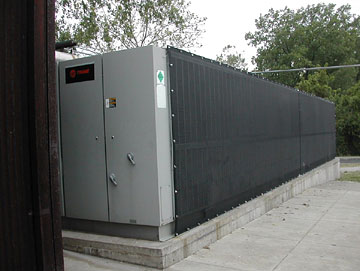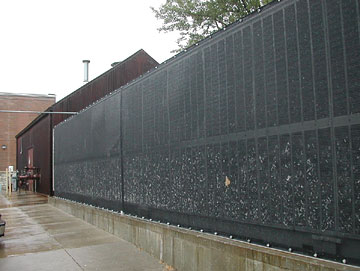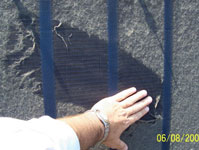Rising energy costs combined with the basic need to optimize cooling and operational efficiency are key forces driving the changes we see in today’s process chiller designs. More and more companies are moving to both “green” preventative maintenance practices and energy efficient equipment that provide greater heat rejection capability at lower operating costs.

Cottonwood Filter Screens Protecting a 400 Ton Chiller
When adopting green maintenance practices, companies are realizing the importance of protecting their condenser coils and are widely using air intake filter technology commonly known as “Cottonwood Filter Screens”. When mounted over the condenser coils on older equipment, cottonwood filter screens keep the coils clean so the equipment operates at its designed efficiency level throughout the season.
As most facilities, maintenance and service engineers know – “Going Green” without “breaking the bank” typically requires stepping-up maintenance practices on existing equipment and replacing old equipment only when it can no longer provide the efficiency needed even under the best of maintenance practices. But replacing old machines with new energy efficient equipment doesn’t guarantee you will realize the full efficiency benefit if your maintenance practices don’t prevent fouling of the condenser coils. Note: the term “prevent fouling” is used to distinguish it from the notion that traditional maintenance methods allow coils to go from clean to dirty or, said another way “go from efficient to inefficient” between cleanings vs. practices that protect the coils from fouling in the first place.

400 Ton Chiller with debris on Cottonwood Filter Screen – Rain shown rinsing filters clean.
To provide greater efficiency, many OEM’s have concentrated on refrigerants and condenser coil technologies to achieve heat rejection efficiency never seen before. High efficiency coils known as “Micro Channels” increase the density of coil fins while expanding the heat rejection surface area to enable rapid heat rejection – but if the coils aren’t protected from airborne matter (insects, cottonwood seed, pollen, leaves, etc), then these systems tend to foul faster then non-micro fin systems as a function of the fins being closer together and trapping more debris between them. When this occurs, the high efficiency equipment will not deliver the promise of greater operational efficiencies and lower energy cost.

Non-Stick Surface Enables Debris to Be Easily Removed
Important Point: Coil cleaning, though an unpleasant task is critical to operations; and unless you have system bypasscapability, it typically requires that the chiller be taken “off-line” during cleaning – resulting in expensive down time and lost productivity. However, when coils are protected with Cottonwood Filter Screens – they prevent coil fouling in the first place and reduce the cleaning process to a fraction of the time required using traditional cleaning methods (coil cleaning chemicals and power washers). Cottonwood Filters Screens are not made of an ordinary mesh – rather, they are specifically engineered for use in high volume, high velocity air movement systems with low static pressure impact; further, the “non-stick” mesh surface enables cleaning with a broom, brush, shop vacuum or garden hose – even the rain will rinse them clean – and they never need to be removed for cleaning. In short, Cottonwood Filter Screens can change the dynamics of your maintenance process and enable your equipment to operate at optimal efficiency level, while significantly reducing your maintenance time & effort. And for companies seeking LEED certification, Cottonwood Filter Screens can help you earn cost effective credit points in multiple categories.





